Alfresco Spaces in Luxury Interior Design
Alfresco spaces, derived from the Italian term ‘alfresco meaning ‘in fresh air’, embody the seamless integration of indoor comfort and outdoor freedom. These spaces are designed to extend the living areas of a home into the outdoors, creating environments where one can enjoy nature without sacrificing the luxuries and conveniences of indoor living. The concept of alfresco living has gained significant traction in recent years, particularly in the realm of luxury interior design.
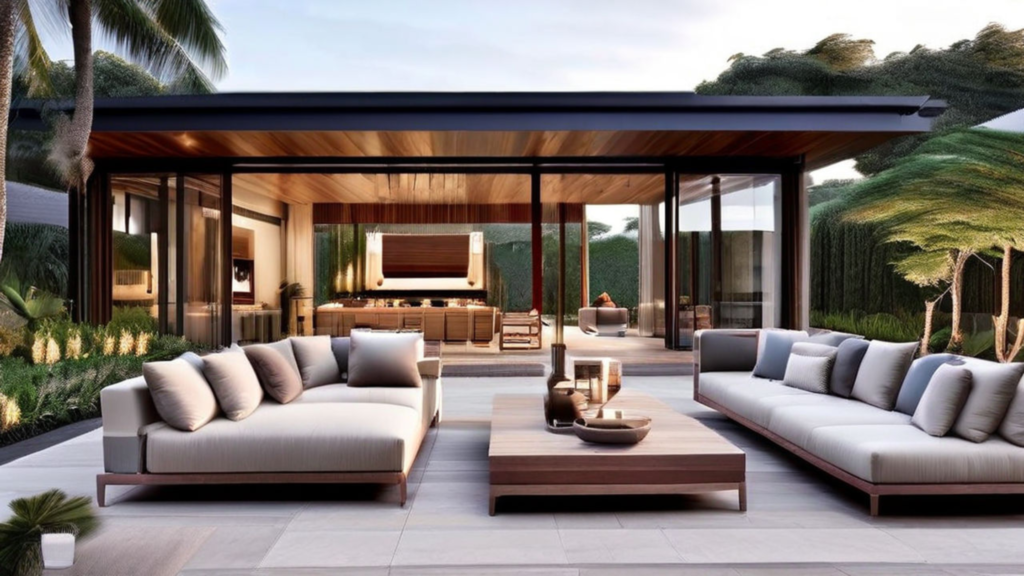
Table of Contents
Key Elements of Alfresco Spaces
Outdoor Furniture: Materials, Comfort, and Style
Outdoor furniture is the cornerstone of any alfresco space. The choice of materials is crucial for durability and aesthetics. High-quality materials such as teak, wrought iron, and all-weather wicker are popular for their ability to withstand the elements while maintaining a stylish appearance. Teak, for instance, is known for its natural resistance to water and pests, making it ideal for outdoor use. Wrought iron offers a classic, elegant look, and can be treated to resist rust and corrosion.
Comfort is another essential aspect. Plush cushions made from weather-resistant fabrics like Sunbrella provide both comfort and longevity, ensuring that the furniture remains inviting and in good condition despite exposure to the elements.
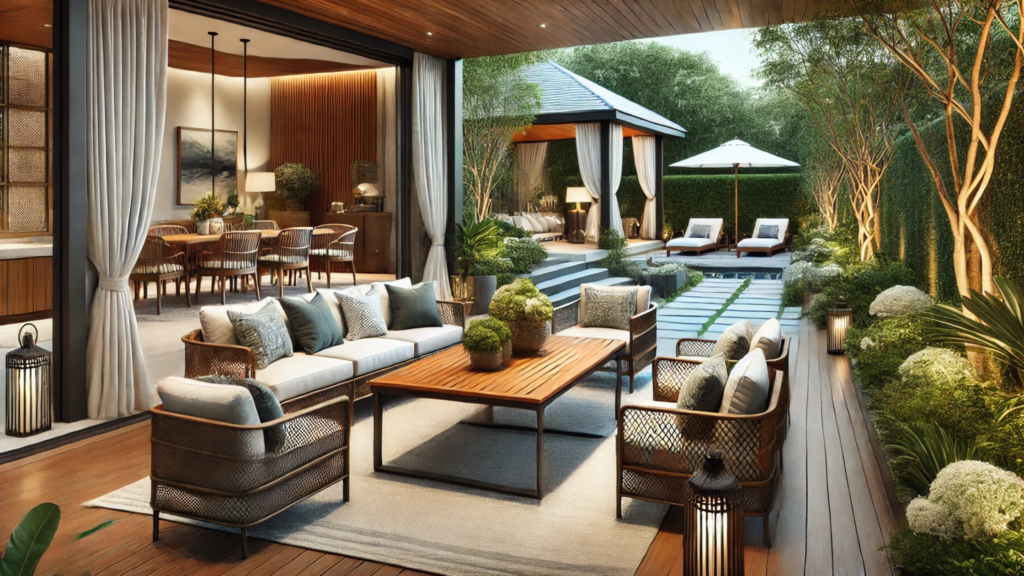
Lighting: Creating Ambience with Outdoor Lighting
Lighting plays a pivotal role in creating the right ambience in alfresco spaces. A well-thought-out lighting plan combines different types of lighting to serve various purposes. Ambient lighting, such as string lights or lanterns, provides a warm, inviting glow that makes the space feel cosy and welcoming. Task lighting, like spotlights or pendant lights over dining areas, ensures that the space is functional and practical.
Accent lighting can be used to highlight specific features, such as architectural elements, sculptures, or water features, adding depth and interest to the design. Solar-powered lights are an eco-friendly option that harnesses natural energy, reducing the environmental footprint while enhancing the outdoor space.
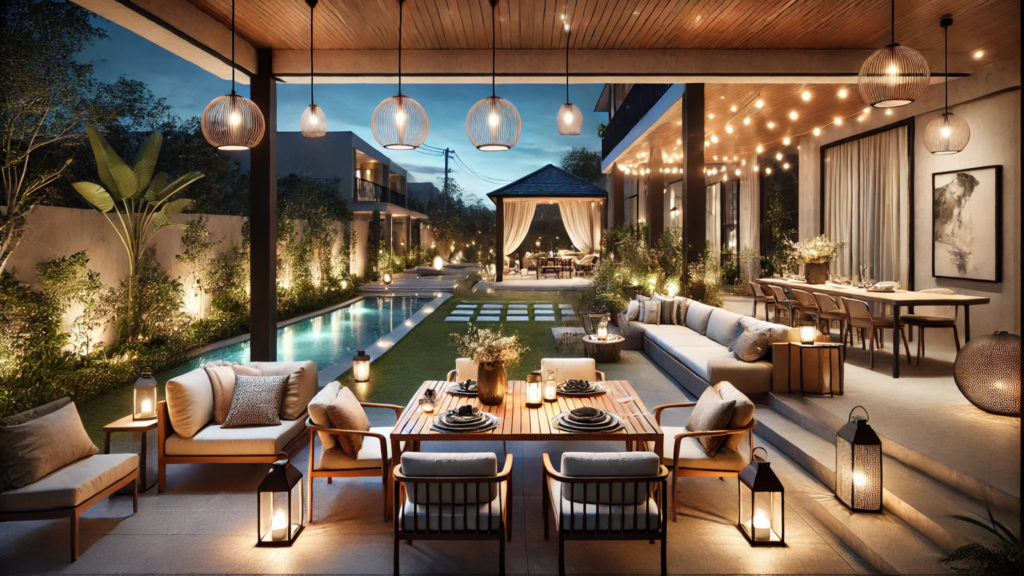
Textiles: Use of Weather-Resistant Fabrics
Textiles bring colour, texture, and comfort to alfresco spaces. However, they must be chosen carefully to withstand outdoor conditions. Weather-resistant fabrics like Sunbrella are engineered to resist fading, mould, and mildew, ensuring longevity and maintaining their vibrant appearance. These fabrics are used for cushions, pillows, rugs, and even outdoor curtains, adding a layer of luxury and comfort while being practical for outdoor use.
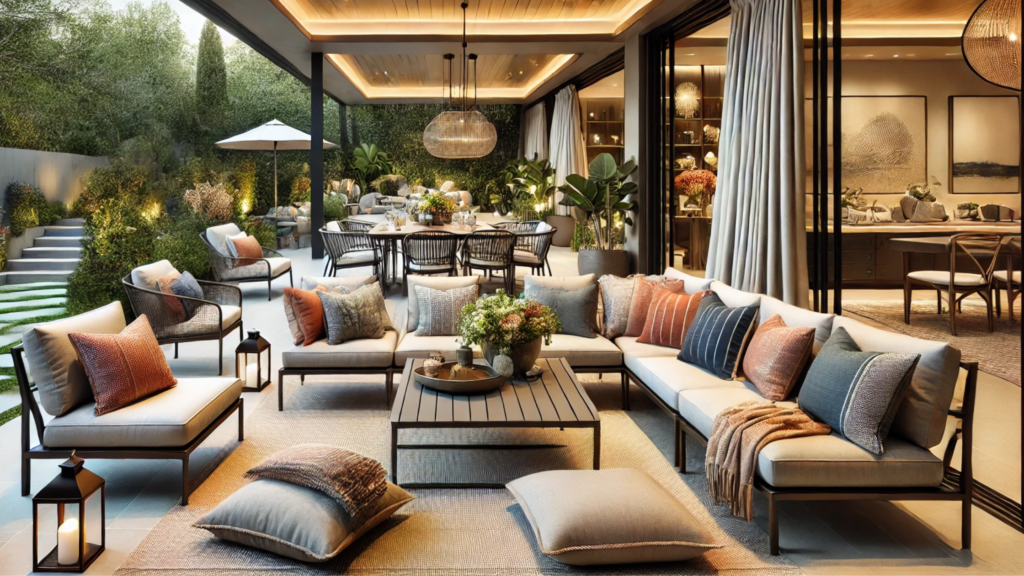
Greenery: Incorporating Plants and Natural Elements
Incorporating greenery is essential for creating a serene and inviting alfresco space. Plants not only enhance the aesthetic appeal but also improve air quality and provide a natural cooling effect. Consider a mix of potted plants, vertical gardens, and strategically placed shrubs to create a lush, green environment. Natural elements like stone, wood, and water can also be integrated into the design. For instance, a wooden pergola can provide shade and structure, while stone pathways and planters add a rustic, organic feel.
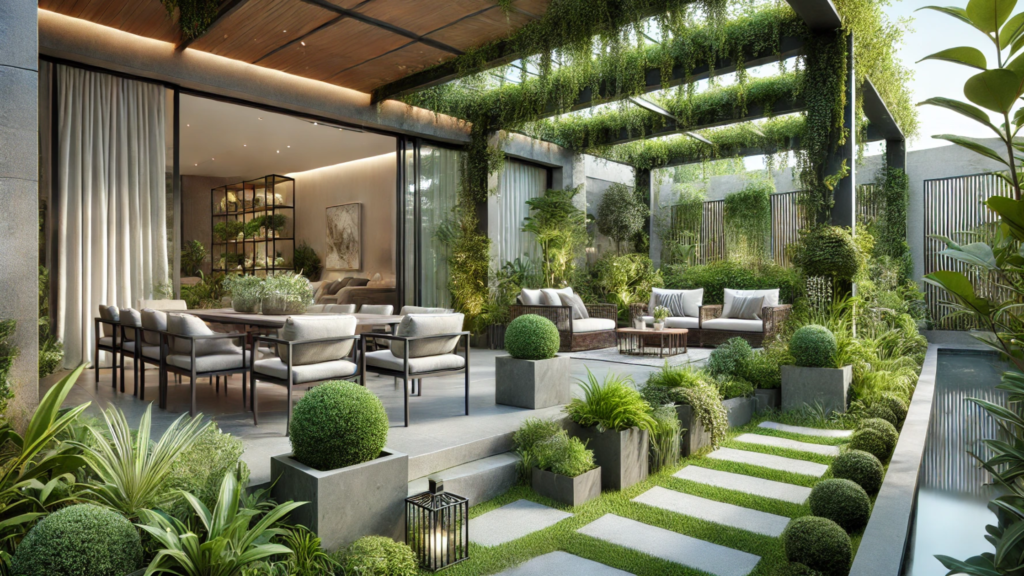
Water Features: Adding Luxury with Fountains and Pools
Water features are a hallmark of luxury alfresco spaces, adding a sense of tranquillity and sophistication. The sound of flowing water from fountains or waterfalls can create a calming atmosphere, making the outdoor space more relaxing. Pools, whether full-sized or smaller plunge pools, offer both aesthetic appeal and functional benefits, serving as focal points for recreation and entertainment. For smaller spaces, consider features like tabletop fountains or wall-mounted water elements that provide the soothing benefits of water without taking up much space.
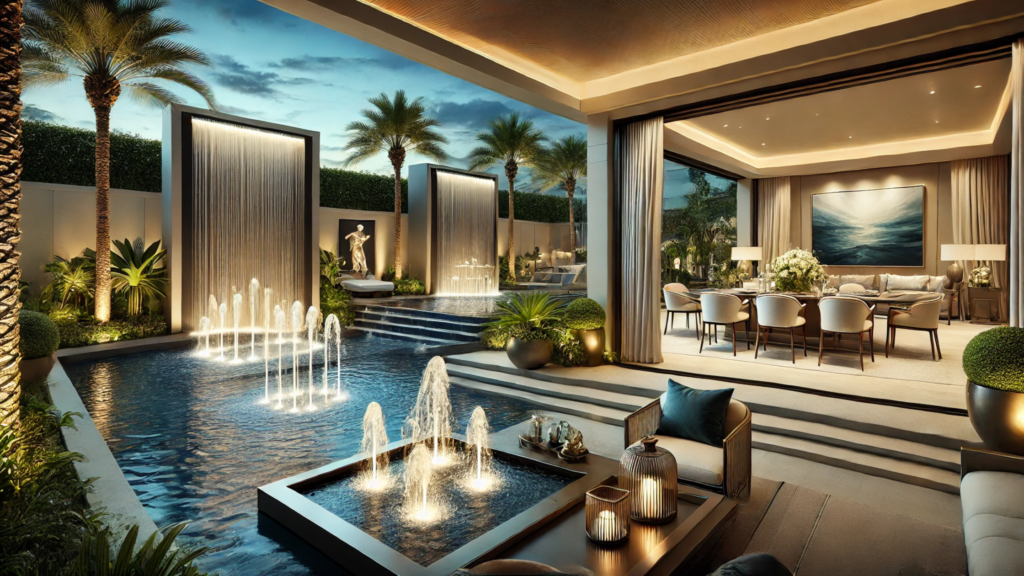
By carefully selecting and integrating these key elements, homeowners can create alfresco spaces that are not only beautiful and inviting but also functional and enduring, offering a seamless extension of their indoor luxury living.
Designing Your Alfresco Space
Planning and Layout
The first step in designing an alfresco space is planning the layout to maximise space and ensure a natural flow. Begin by assessing the available area and identifying the primary functions you want the space to serve, such as dining, lounging, or entertaining. Create distinct zones for each activity, ensuring there is enough room for movement and interaction between these areas.
Consider the orientation of your space in relation to the sun and prevailing winds to optimise comfort. Use outdoor rugs, planters, and low walls to define different areas without obstructing the flow.
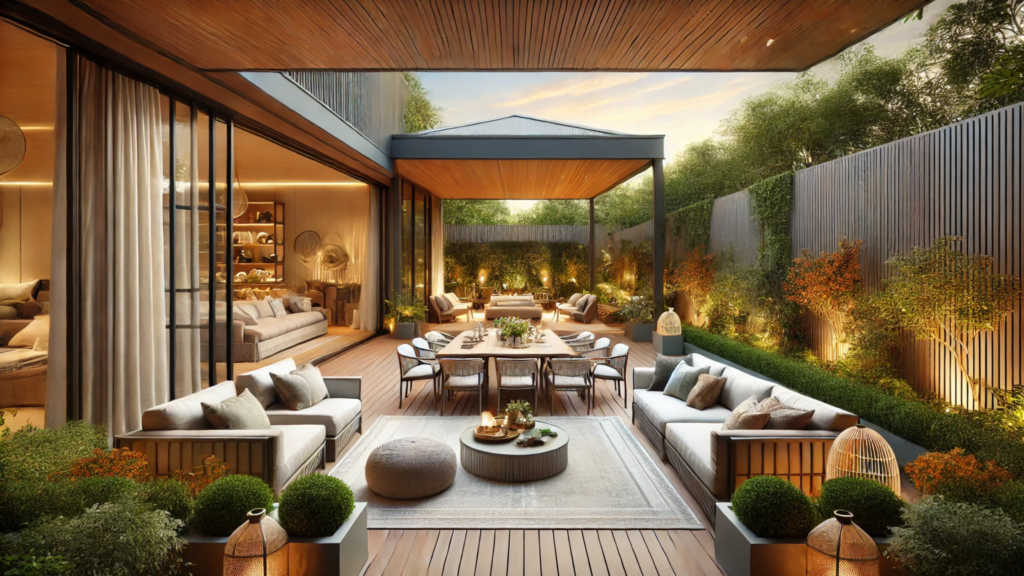
Style and Theme
Choosing a cohesive design theme is crucial for creating a visually appealing alfresco space. Your outdoor area should reflect the overall aesthetic of your home while also embracing its unique outdoor environment. Decide on a theme that resonates with your personal style and complements your home’s architecture. Select a consistent colour palette that enhances the natural surroundings and ties the various elements of your space together. For instance, neutral tones can provide a serene backdrop, while bold colours can add vibrancy and energy. Select a consistent colour palette that enhances the natural surroundings and ties the various elements of your space together. For instance, neutral tones can provide a serene backdrop, while bold colours can add vibrancy and energy.
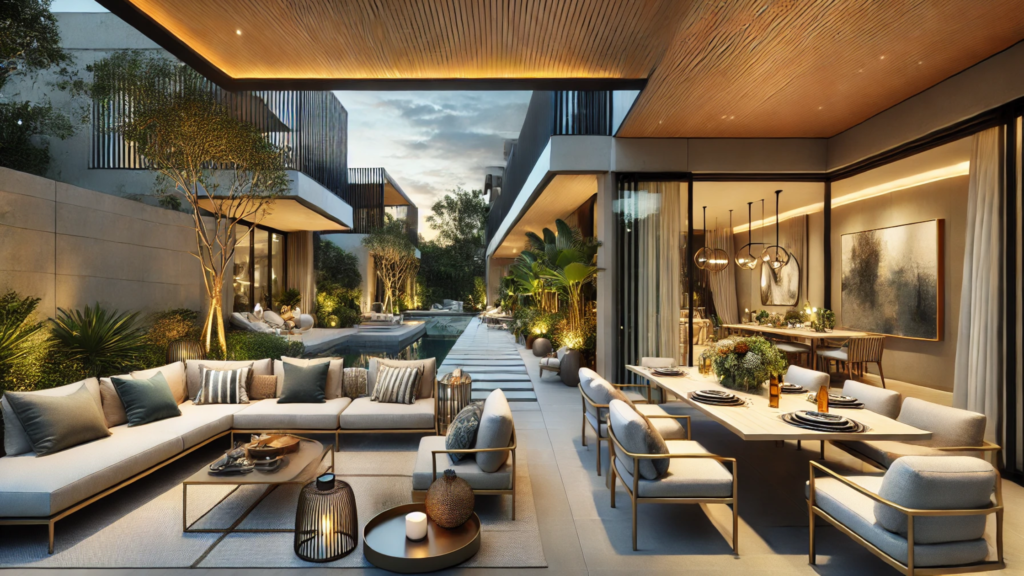
Functionality
Functionality is key to a successful alfresco design. The space should cater to your lifestyle and needs, whether it’s hosting large gatherings, enjoying quiet family dinners, or creating a personal retreat. Start by listing the essential features you require, such as a dining area, cooking station, lounging zone, or play area for children. Consider the practical aspects like weather conditions and maintenance.
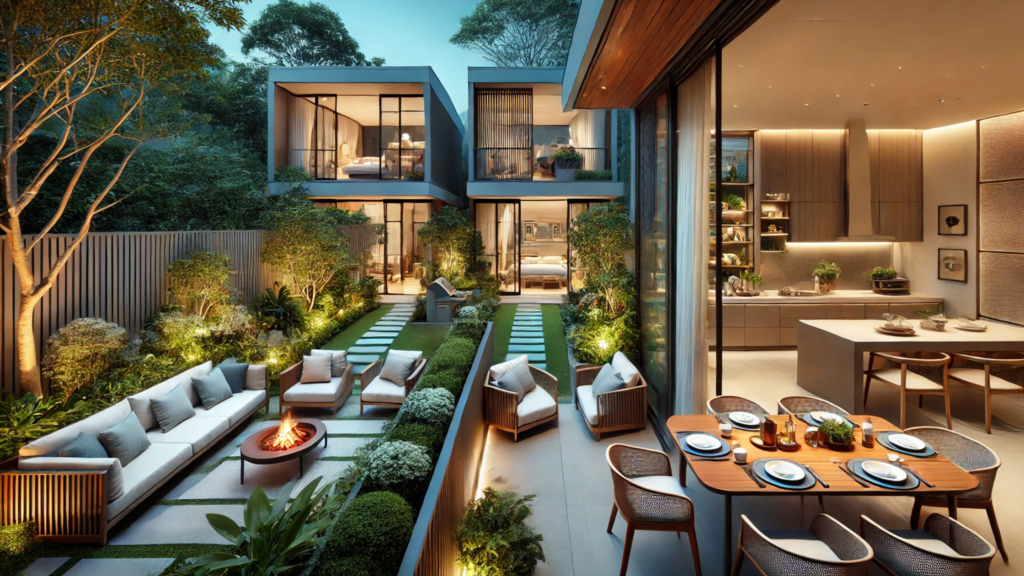
Comfort and Luxury
To elevate your alfresco space, focus on comfort and luxury. High-end amenities not only enhance the aesthetic appeal but also provide a sense of indulgence and relaxation. Start with comfortable seating options featuring plush, weather-resistant cushions and ergonomic designs. Consider adding a mix of seating types, such as sofas, lounge chairs, and hammocks, to create a versatile and inviting environment. Incorporate luxury features like an outdoor kitchen or bar for seamless entertaining.
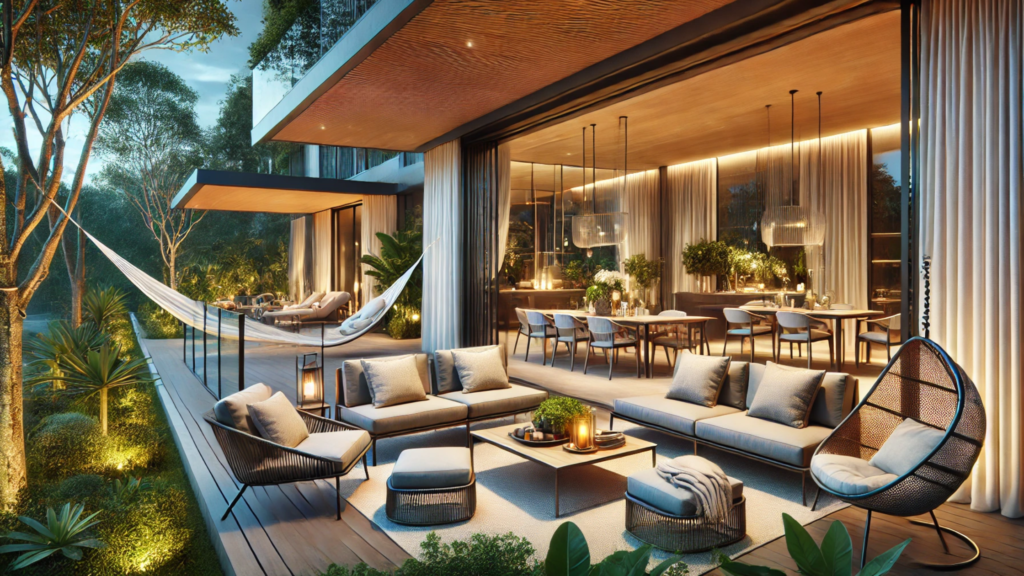
Trends in Alfresco Design
Outdoor interior design is continually evolving, with new trends emerging to enhance the functionality, aesthetics, and sustainability of alfresco spaces. Here’s an in-depth look at some of the current trends:
Sustainable Design: Eco-Friendly Materials and Practices
Sustainable design is at the forefront of modern outdoor interior design. Homeowners are increasingly opting for eco-friendly materials and practices to minimise their environmental impact. This includes using recycled or reclaimed materials for furniture and structures, such as wood, metal, and even plastic. Sustainable design also emphasises the use of natural, biodegradable materials like bamboo and cork, which have a lower environmental footprint. In addition to material choices, sustainable practices include rainwater harvesting systems, solar-powered lighting, and energy-efficient outdoor appliances.
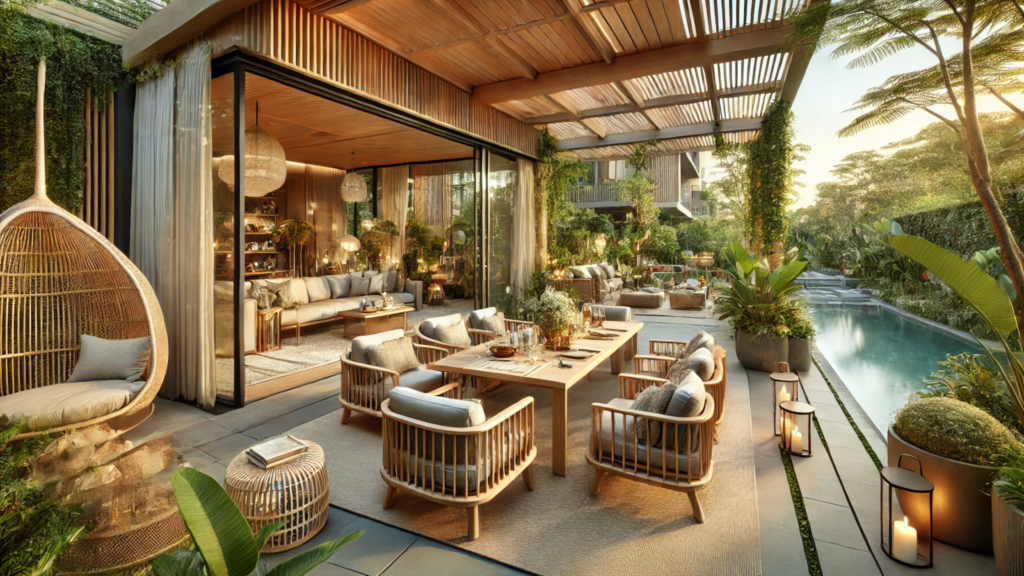
Smart Technology: Integrating Smart Home Features Outdoors
Smart technology is revolutionising outdoor interior design by integrating modern conveniences into alfresco spaces. Smart lighting systems, controlled via smartphone apps or voice commands, allow homeowners to adjust lighting to suit different moods and activities. Automated irrigation systems can optimise water usage, ensuring plants are properly watered without waste.
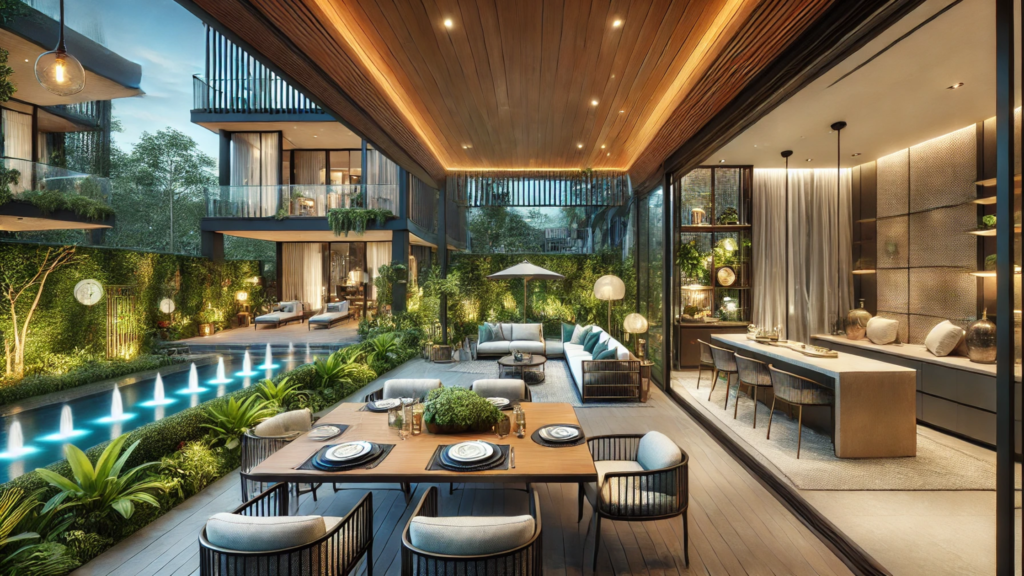
Mixed Materials: Combining Different Textures and Materials
Combining different textures and materials is a growing trend in outdoor interior design, adding depth and visual interest to alfresco spaces. Mixing materials like wood, metal, stone, and glass creates a dynamic, layered look that is both modern and timeless. For example, pairing sleek metal furniture with natural wood accents can create a contemporary yet warm atmosphere. Textural contrasts, such as smooth concrete surfaces against rough stone walls or soft fabric cushions on metal frames, enhance the sensory experience of the space.
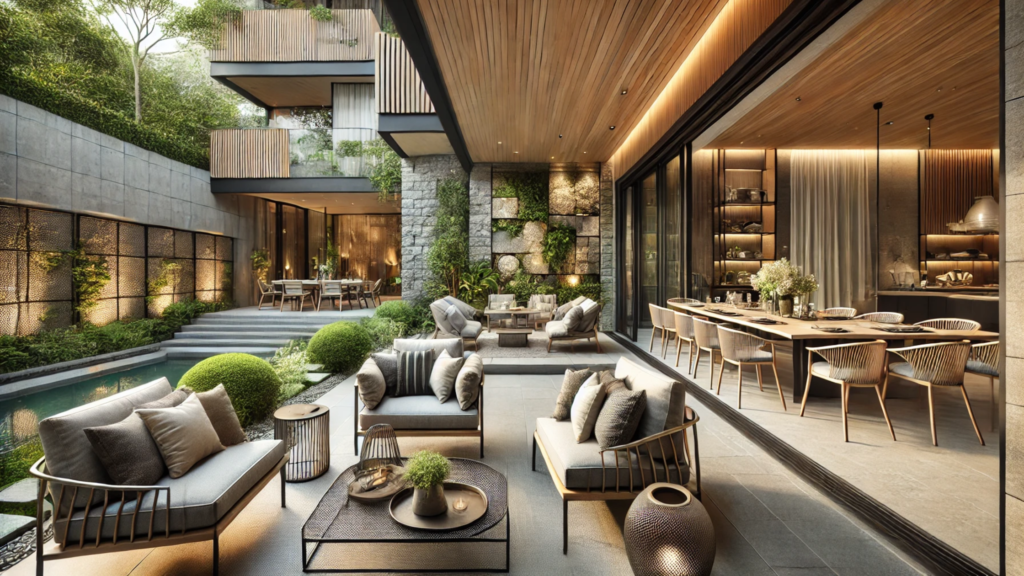
Indoor-Outdoor Flow: Seamlessly Blending Indoor and Outdoor Spaces
The concept of indoor-outdoor flow is all about creating a seamless transition between interior and exterior living spaces. Large sliding or folding glass doors are a popular feature, allowing for unobstructed views and easy access between the two areas. Continuity in flooring materials, such as extending the same tiles or wood from indoors to outdoors, enhances the sense of cohesion. Furniture and decor that complement indoor pieces help blur the boundaries between the spaces.
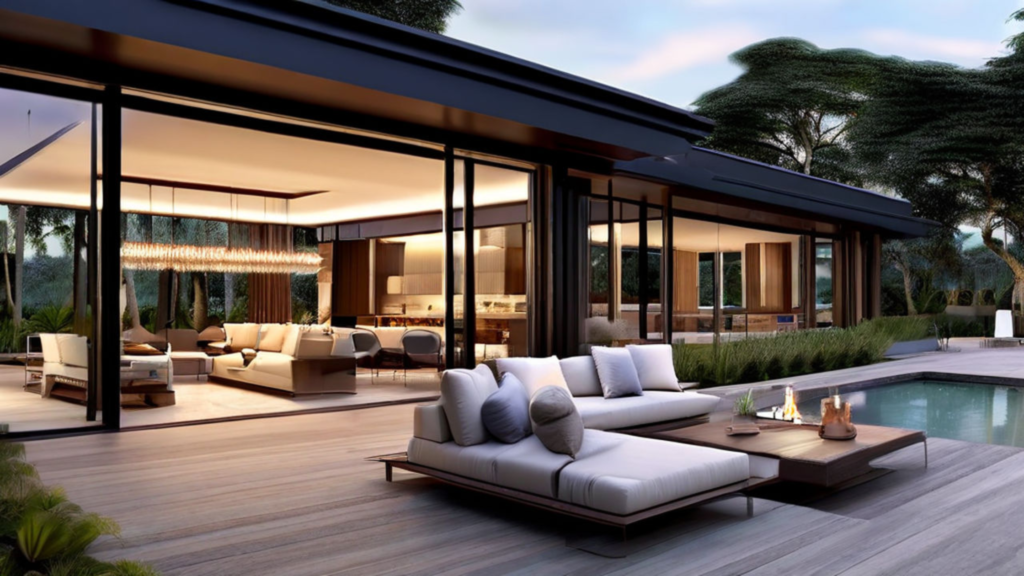
Seasonal Adaptability: Designing for Year-Round Use
Designing alfresco spaces for year-round use ensures that they remain functional and enjoyable regardless of the season. This involves incorporating features that provide comfort and protection from the elements. Retractable awnings, pergolas, and shade sails offer relief from the sun during the summer months, while outdoor heaters, fire pits, and enclosed patios provide warmth in colder weather. Selecting weather-resistant furniture and materials that can withstand seasonal changes is crucial for maintaining the longevity and appeal of the space.
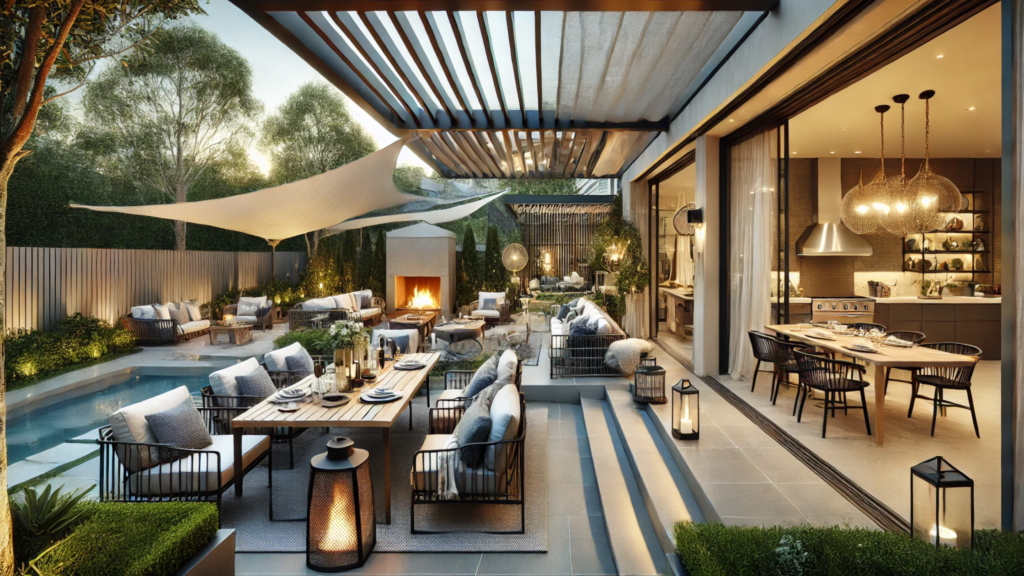
Essential Interior Design Ideas for Adopting Alfresco Design
Budgeting for Luxury: Smart Investments for High-End Results
Investing wisely is key to achieving a high-end alfresco space without overspending. Start by establishing a clear budget and prioritising areas that will have the most impact. Allocate a significant portion of your budget to high-quality, durable materials and essential features like comfortable seating, a sturdy dining set, and quality lighting. These elements will not only enhance the aesthetic appeal but also ensure longevity and practicality. Consider investing in multi-functional furniture pieces that offer flexibility and maximise the use of your space.
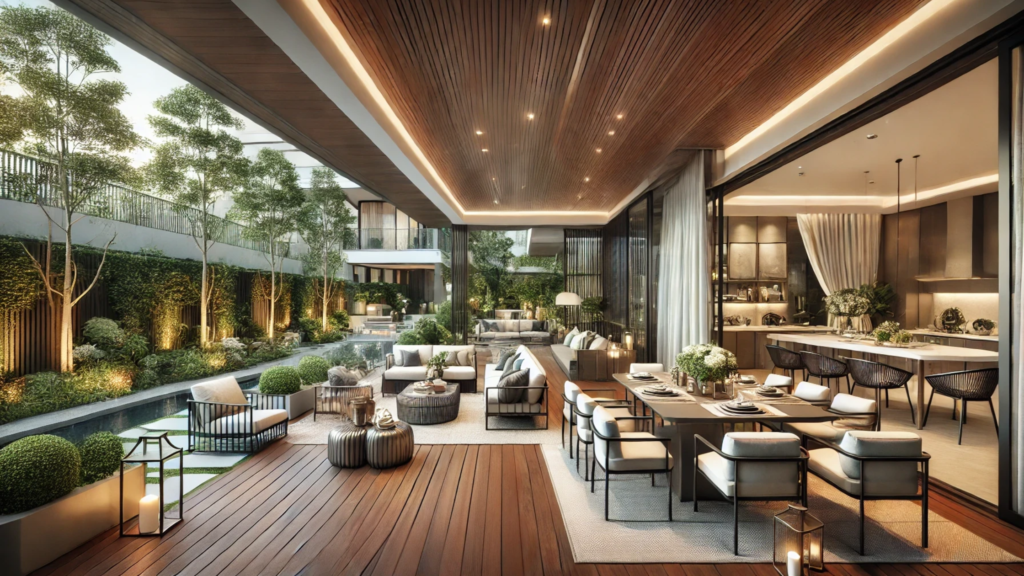
Personalisation: Tailoring the Space to Personal Taste
Personalisation is crucial for making your alfresco space uniquely yours. Start by considering your lifestyle and how you intend to use the space. Whether you love hosting large gatherings, enjoying quiet family dinners, or creating a serene retreat, your design should reflect your preferences and needs. Incorporate elements that resonate with your personal style, such as custom-built furniture, unique lighting fixtures, or bespoke outdoor art.
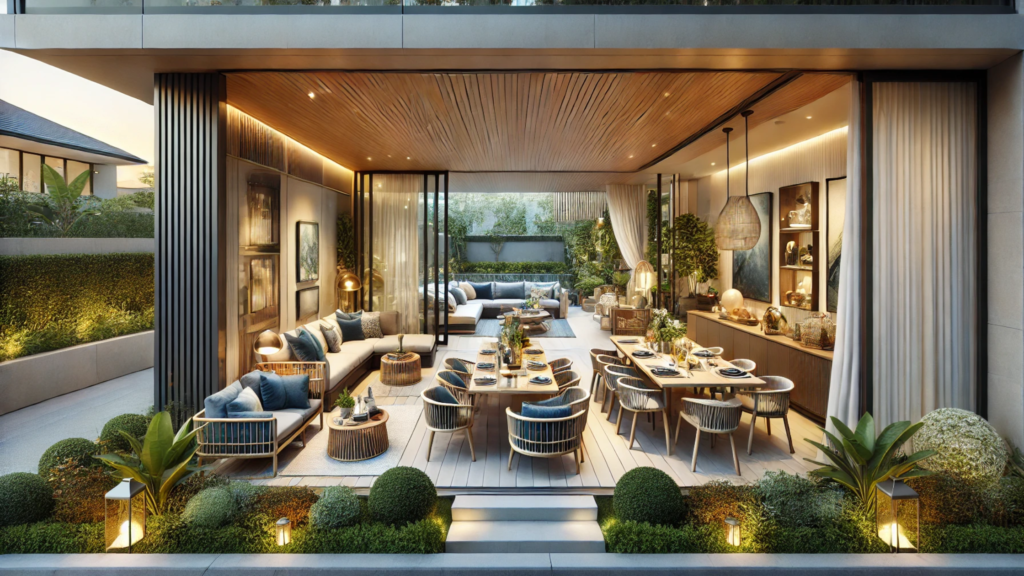
Maintenance and Longevity: Keeping Your Alfresco Space Pristine
Maintaining your alfresco space is essential for preserving its beauty and functionality. Regular upkeep will not only extend the life of your investments but also ensure the space remains inviting year-round.
Start with a maintenance schedule that includes cleaning furniture, washing textiles, and checking for wear and tear. Use protective covers for furniture during harsh weather conditions and store cushions and fabrics when not in use. Regularly inspect and treat wooden elements to prevent damage from moisture and pests. For metal furniture, apply rust-resistant treatments as needed.
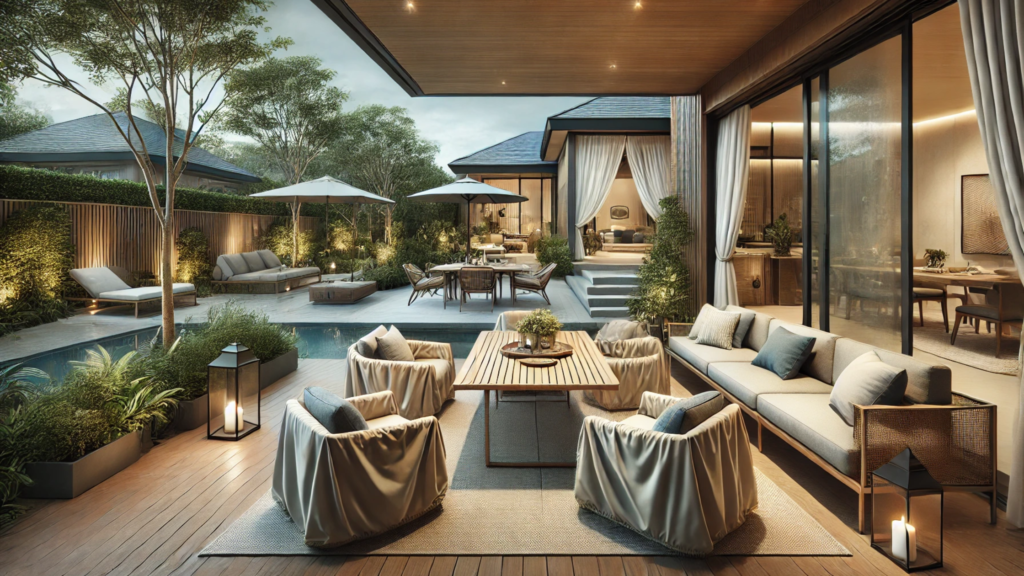
Conclusion
Alfresco areas have evolved from simple outdoor setups into sophisticated extensions of contemporary luxurious homes. At SJ Design Consultants, we consider that those spaces are not just about aesthetics—they may be about improving life. By integrating consolation, beauty, and capability, alfresco design bridges the space between nature and structure, providing homeowners a sanctuary that is each tranquil and tailored.
Whether you’re embracing sustainable practices, incorporating clever generation, or really curating a serene retreat for private leisure, the possibilities with alfresco spaces are limitless. With considerate planning, pleasant materials, and personalized touches, you could rework any out of doors region right into a timeless haven of luxurious and comfort.
Ready to reimagine your outside dwelling? Let SJ Design Consultants help you craft a space that breathes beauty in every detail.
Frequently Asked Questions (FAQs)
What are alfresco spaces, and why are they important in luxury interior design?
- Alfresco spaces are outdoor areas that seamlessly integrate with indoor living spaces, designed for relaxation, dining, and entertaining.
- They are significant in luxury interior design because they extend the living area of a home, allowing for a harmonious blend of indoor comfort and outdoor beauty.
- These spaces offer a versatile environment that enhances the overall living experience, making homes more spacious and inviting.
- In luxury design, alfresco areas are crafted with the same attention to detail and high-quality materials as indoor spaces, creating an elegant and cohesive aesthetic throughout the property.
How can I incorporate sustainable design into my alfresco space?
- Incorporating sustainable design into your alfresco space involves selecting eco-friendly materials and practices.
- Use recycled or reclaimed materials for furniture and structures, and choose natural, biodegradable options like bamboo and cork. Implement energy-efficient systems, such as solar-powered lighting and automated irrigation to conserve water.
- Plant drought-tolerant and native species to reduce water usage and maintenance needs. Sustainable design not only benefits the environment but also creates a healthier and more durable outdoor space.
What are the benefits of integrating smart technology into alfresco spaces?
- Integrating smart technology into alfresco spaces offers numerous benefits, including convenience, efficiency, and enhanced functionality. Smart lighting systems allow for easy control of outdoor lighting via apps or voice commands, creating the perfect ambiance for any occasion.
- Automated irrigation systems ensure optimal water usage, keeping plants healthy while reducing waste. Outdoor entertainment systems, such as weather-resistant TVs and speakers, transform alfresco spaces into versatile multimedia hubs.
- Additionally, smart security features like cameras and motion sensors enhance safety and provide peace of mind.
How do I achieve a seamless indoor-outdoor flow in my design?
- Achieving a seamless indoor-outdoor flow involves creating a visual and functional connection between your interior and exterior spaces. Large sliding or folding glass doors provide unobstructed views and easy access, blurring the boundaries between indoors and outdoors.
- Continuity in flooring materials, such as using the same tiles or wood for both areas, enhances the sense of cohesion. Matching furniture styles and decor themes further unify the spaces.
- This approach not only expands the living area but also fosters a stronger connection with nature, enhancing the overall aesthetic and energy of your home.
SJ DESIGN CONSULTANTS
Transforming your vision into reality. Explore designs that inspire, elevate, and redefine your lifestyle with SJ Design Consultants.
